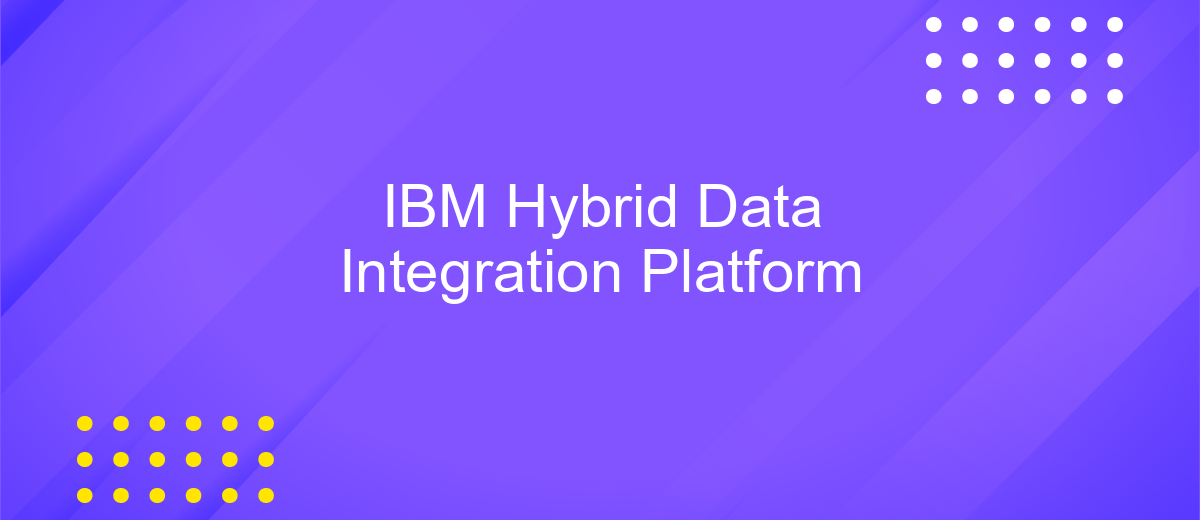IBM Hybrid Data Integration Platform
The IBM Hybrid Data Integration Platform is a robust solution designed to seamlessly connect diverse data environments, both on-premises and in the cloud. As organizations increasingly adopt hybrid infrastructures, this platform offers comprehensive tools to integrate, manage, and analyze data from various sources. By facilitating efficient data flow and ensuring data consistency, IBM empowers businesses to drive innovation and make informed decisions in a rapidly evolving digital landscape.
Introduction to IBM Hybrid Data Integration Platform
The IBM Hybrid Data Integration Platform is a cutting-edge solution designed to streamline and enhance data management across diverse environments. It addresses the growing need for seamless data integration in a world where information is scattered across on-premises systems, cloud services, and hybrid infrastructures. By leveraging advanced technologies, the platform ensures that organizations can efficiently connect, transform, and utilize their data assets.
- Comprehensive connectivity: Supports a wide range of data sources, from traditional databases to modern cloud-based applications.
- Scalability: Easily adapts to the changing needs of businesses, facilitating growth and expansion.
- Security: Implements robust measures to protect sensitive data during integration processes.
- User-friendly interface: Simplifies complex data workflows with intuitive tools and features.
With IBM's Hybrid Data Integration Platform, businesses can achieve greater agility and insight by breaking down data silos and enabling real-time analytics. This empowers decision-makers with timely, accurate information, fostering innovation and competitive advantage. As organizations continue to embrace digital transformation, IBM's platform stands out as a reliable partner in navigating the complexities of hybrid data integration.
Key Features and Capabilities

IBM Hybrid Data Integration Platform offers a comprehensive suite of features designed to streamline and enhance data management across diverse environments. One of its key capabilities is seamless connectivity, enabling organizations to integrate data from various sources, whether on-premises or in the cloud. This platform supports real-time data synchronization, ensuring that businesses have access to the most current information for decision-making. Additionally, it offers robust data transformation tools, allowing users to cleanse, enrich, and transform data to meet specific business needs.
The platform's user-friendly interface simplifies the integration process, making it accessible even to those with limited technical expertise. With the inclusion of services like ApiX-Drive, users can further automate and customize their data workflows, connecting multiple applications and services effortlessly. Security is a top priority, with advanced encryption and access controls to safeguard sensitive data. Moreover, the platform is highly scalable, accommodating growing data volumes and evolving business requirements. These features make IBM Hybrid Data Integration Platform a powerful solution for organizations looking to optimize their data integration strategies.
Benefits of Using IBM's Hybrid Data Integration Platform

IBM's Hybrid Data Integration Platform offers a robust solution for businesses seeking seamless data management across diverse environments. This platform facilitates the integration of on-premises and cloud data, enabling organizations to leverage their existing infrastructure while embracing modern cloud technologies. By ensuring data consistency and accessibility, it empowers businesses to make informed decisions quickly.
- Scalability: The platform supports dynamic scaling, accommodating growing data needs without compromising performance.
- Security: With advanced security features, it safeguards sensitive data, ensuring compliance with industry standards.
- Flexibility: Its hybrid nature allows integration with various data sources, offering unparalleled flexibility and adaptability.
- Cost Efficiency: By optimizing resource usage, it reduces operational costs, providing a cost-effective solution for data integration.
- Real-time Insights: The platform enables real-time data processing, allowing businesses to gain timely insights and enhance decision-making.
By leveraging IBM's Hybrid Data Integration Platform, organizations can unlock the full potential of their data assets. This platform not only bridges the gap between traditional and modern data environments but also drives innovation and efficiency. As a result, businesses can stay competitive in a rapidly evolving digital landscape, ensuring sustainable growth and success.
Use Cases and Examples

The IBM Hybrid Data Integration Platform is a versatile solution designed to address diverse data integration needs across industries. By enabling seamless connectivity between on-premises and cloud environments, it empowers organizations to efficiently manage and utilize their data assets. This platform supports real-time data synchronization, ensuring that businesses can make informed decisions based on the most current information available.
One of the primary use cases for the IBM Hybrid Data Integration Platform is in the financial sector, where real-time data integration is crucial for risk management and compliance. Another significant application is in healthcare, where the platform facilitates secure and efficient data exchange between different healthcare systems, improving patient care and operational efficiency.
- Retail: Enhances customer experience by integrating data from various sources for personalized marketing.
- Manufacturing: Streamlines supply chain operations through real-time data analytics.
- Telecommunications: Improves service delivery by integrating customer data for better support.
By leveraging the IBM Hybrid Data Integration Platform, businesses can break down data silos and create a unified data ecosystem. This enables organizations to innovate faster, respond to market changes more effectively, and ultimately drive better business outcomes. The platform's adaptability ensures it can meet the evolving needs of any industry, making it an invaluable asset for digital transformation initiatives.


Conclusion and Future Directions
In conclusion, the IBM Hybrid Data Integration Platform stands as a robust solution for enterprises seeking to streamline their data management processes. By offering seamless integration capabilities across diverse environments, it empowers organizations to harness the full potential of their data assets. The platform's ability to connect on-premises systems with cloud-based applications ensures that businesses can maintain agility and responsiveness in a rapidly evolving digital landscape.
Looking ahead, the future of data integration lies in further enhancing automation and simplifying configuration processes. Services like ApiX-Drive, which facilitate the effortless setup of integrations, are likely to play a pivotal role in this evolution. By reducing the complexity involved in connecting disparate systems, these tools will enable companies to focus on deriving actionable insights from their data. As the demand for real-time data access and analytics grows, the IBM Hybrid Data Integration Platform, complemented by innovative services like ApiX-Drive, will continue to be at the forefront of enabling efficient and scalable data solutions.
FAQ
What is IBM Hybrid Data Integration Platform?
How does IBM Hybrid Data Integration Platform support real-time data integration?
What are the key components of IBM Hybrid Data Integration Platform?
How can businesses automate data integration processes with IBM Hybrid Data Integration Platform?
What are the benefits of using IBM Hybrid Data Integration Platform for organizations?
Do you want to achieve your goals in business, career and life faster and better? Do it with ApiX-Drive – a tool that will remove a significant part of the routine from workflows and free up additional time to achieve your goals. Test the capabilities of Apix-Drive for free – see for yourself the effectiveness of the tool.

